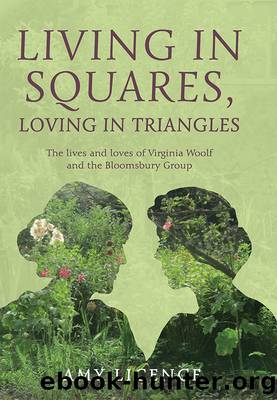Living in Squares, Loving in Triangles: The Lives and Loves of Viginia Woolf and the Bloomsbury Group by Amy Licence

Author:Amy Licence [Licence, Amy]
Language: eng
Format: epub
Tags: Biography & Autobiography, Artists; Architects; Photographers, Historical, history, social history
ISBN: 9781445645759
Google: 8__PrQEACAAJ
Publisher: Amberley
Published: 2015-11-15T23:56:10.636277+00:00
THIRTEEN
Omega, 1913â1914
The artist is the man who creates, not only for need, but for joy.1
The Second Post-Impressionist Exhibition opened at the Grafton Galleries on 5 October 1912, with the intention of highlighting the most recent developments in France, England and Russia. Cezanne, Picasso, Gauguin, Bonnard and other established masters were included, and Roger set up his easel to paint the entire room that was devoted to Matisse. He also had the assistance of the Russian mosaicist Boris Anrep, a friend of Henry Lamb, who sourced a number of works from his homeland including those of Natalia Goncharova and Mikhail Larionov. In addition, Fry invited contemporary British artists to exhibit, including Frederick and Jessie Etchells, Stanley Spencer, Spencer Gore, Wyndham Lewis and Eric Gill, many of whom were members of the Camden Town Group, which met in Sickertâs studio from 1911. Leonard was appointed as secretary, to assist with the hanging of the paintings and to field off the publicâs comments: âEvery now and then some well-groomed, red-faced gentleman, oozing the undercut of the best beef and the most succulent of chops, carrying his top hat and grey suede gloves, would come up to my table and abuse the pictures and me with the greatest rudeness.â Duncan and Vanessa selected several works each to contribute: in fact, Duncan designed the iconic poster for the show, featuring a society lady in shock at the pictures, based on an idea by Vanessa. The poster played with the concept of audience disapproval, capturing this response in a Post-Impressionist style which made the visitorâs reactions part of the art itself, essentially a performance played out in the galleries.
Duncan exhibited six works: portraits of Roger Fryâs daughter Pamela, artist Henry Doucet and Ka Cox, as well as The Dancers, The Countess and The Queen of Sheba. A significant shift was visible in his style since the staging of the previous exhibition, undoubtedly due to the influence of Europe and Post-Impressionism. Prior to that, he had adopted an Impressionistic but very English style in the richly coloured portrait of Lytton Strachey reading Crime and Punishment and the sombre, solid Lemon Gatherers of 1909â10, which had been inspired by Sicilian dancers appearing at the Shaftesbury Theatre. However, there was a marked difference between these and Dancers, which Duncan had painted in 1911 after meeting Matisse in his studio. Exhibited in Paris in April 1912, Dancers was also a graceful tribute to the bright colours and solid forms of Cezanne, Van Gogh and Gauguin. Similarly fluid and light works from this time included Footballers and Bathers, where Duncan captured movement and form amid increasingly abstract settings; the water of Bathers is reduced to a series of wavy parallel lines and the sky is touched with a mottled effect, often known as Duncanâs âleopard spotâ style. He experimented further with pointillism in 1912, when Lytton and Pippa Strachey posed for the Queen of Sheba, perhaps influenced by Carl Goldmarkâs opera of that name, which premiered in London in the winter of 1911.
Download
This site does not store any files on its server. We only index and link to content provided by other sites. Please contact the content providers to delete copyright contents if any and email us, we'll remove relevant links or contents immediately.
Machine Learning at Scale with H2O by Gregory Keys | David Whiting(4094)
Never by Ken Follett(3758)
Harry Potter and the Goblet Of Fire by J.K. Rowling(3758)
Unfinished: A Memoir by Priyanka Chopra Jonas(3313)
Fairy Tale by Stephen King(3192)
The Man Who Died Twice by Richard Osman(2977)
Will by Will Smith(2766)
Rationality by Steven Pinker(2271)
The Dark Hours by Michael Connelly(2214)
It Starts With Us (It Ends with Us #2) by Colleen Hoover(2171)
The Storyteller by Dave Grohl(2147)
Can't Hurt Me: Master Your Mind and Defy the Odds - Clean Edition by David Goggins(2142)
The Dawn of Everything: A New History of Humanity by David Graeber & David Wengrow(2103)
Friends, Lovers, and the Big Terrible Thing by Matthew Perry(2097)
The Becoming by Nora Roberts(2057)
The Stranger in the Lifeboat by Mitch Albom(2030)
Cloud Cuckoo Land by Anthony Doerr(2012)
Einstein: His Life and Universe by Walter Isaacson(1952)
Love on the Brain by Ali Hazelwood(1931)
